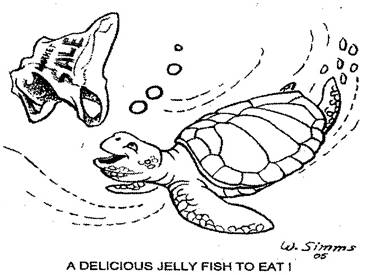Appeared in Vall-E-Vents, the San Fernanado Valley Sierra Club Newsletter, July 2005.
Plastics for Dinner
(#2 of the Plastics Plague series)
by Sarah S. Mosko, Ph.D.

Most litter eventually finds it way to the ocean. Illustration by Willis Simms.
Most litter eventually finds it way to the ocean. Plastics bags are swept in by winds, while heavier trash washes in via rainstorm run-off. Dumping at sea and cargo spills account for only 20% of trash in our oceans, with 80% from land-based sources.
Just about everything today is made from plastic it seems. Since plastics do not biodegrade, but rather break into smaller plastic fragments, our oceans are awash with plastic debris. Nearly 90% of ocean debris is in fact plastic. There are even areas of ocean where plastic fragments outweigh zooplankton by a factor of six to one. Unfortunately, sea creatures are not equipped to discriminate plastics from their normal diet. The consequences are devastating.
A plastic bag floating in water probably looks a lot like a jellyfish to a hungry sea turtle. Hard plastic fragments resemble krill, small shrimp-like crustaceans favored by many sea animals. The  pearl-sized plastic resin pellets (melted down to form plastic products) that escape from plastic fabrication plants might easily be mistaken for fish eggs. Practically any debris can be mistaken for food. A sea turtle can starve to death when ingested plastics clog its digestive tract. This is particularly true for a baby turtle whose narrow gullet is an easy trap for even small resin pellets. Starvation can also occur when air trapped within an ingested plastic bag prevents a turtle from diving down to feed. Or, it can drown when it gets caught on a plastic bag handle, fishing line, fragment of trawl netting or a 6-pack ring that’s snagged onto a submerged rock.
pearl-sized plastic resin pellets (melted down to form plastic products) that escape from plastic fabrication plants might easily be mistaken for fish eggs. Practically any debris can be mistaken for food. A sea turtle can starve to death when ingested plastics clog its digestive tract. This is particularly true for a baby turtle whose narrow gullet is an easy trap for even small resin pellets. Starvation can also occur when air trapped within an ingested plastic bag prevents a turtle from diving down to feed. Or, it can drown when it gets caught on a plastic bag handle, fishing line, fragment of trawl netting or a 6-pack ring that’s snagged onto a submerged rock.
Sea mammals who encounter plastics suffer similar fates. “Plastic necklaces” of man-made twine, packing straps or trawl netting on dead seals or sea lions tell the story of gradual strangulation as the entrapped animals grow. The playful, inquisitive nature of young seals and sea lions makes them particularly susceptible to entanglement. Similarly, “plastic bracelets” adorning the flippers, tails and flukes of various mammals inhibit their ability to swim and feed. Mammals also face the same problem of discriminating plastics from real food. High levels of debris ingestion are reported in the manatees of Florida. Even whales and dolphins are found emaciated or dead with plastic sheeting or plastic bags in their stomachs.
Perhaps the poster child for the tragic impact of plastics is the Laysan Albatross. Marine scientists describe the now common sightings of dead carcasses literally filled with a myriad of plastics such as bottle and pen caps, chunks of foamed polystyrene, plastic tubing, and even cigarette lighters. Still worse, adult birds are seen feeding plastics to their young. Feeling full or ill from plastics, the chicks refuse fish offered by the parent. Dozens of other species of seabirds are known to be ingesting plastics too. Seabirds are also vulnerable to entanglement, especially in discarded fishing lines and drift nets. The United Kingdom’s Marine Conservation Society, a national environmental nonprofit, finds that more than a million seabirds as well as 100,000 mammals and sea turtles die globally each year because of ingestion or entanglement in plastics. Sea creatures are endowed with little means of defense against the estimated seven billion tons of debris entering the world’s oceans annually.
In the 1950’s when we first glimpsed all the things plastic might do for humans in the name of convenience, we failed to consider how our fellow creatures would be affected. Fifty years later we face a harsh reality – even if we completely stemmed the flow of plastics into the ocean right now, the marine ecosystem will take untold decades, maybe centuries, to clean itself up. I am reminded of the words of the philosopher Hannah Arendt from her book The Banality of Evil: “For these are not remnants of a heroic age, but middens of a culture of distraction and disposability. They are mundane, trivial, unnecessary — and fatal.” And plastics are not just harmful to wildlife. Look for an upcoming article detailing the latest studies on plastics and human health.